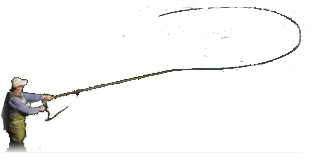
There’s a lot of "ifs" and "either/ors" in determining popper/dropper set-up.
First, the dropper length is normally determined by water depth. You don’t want more dropper leader than the waters depth or you will be dragging the bottom. This is fine for a worm fly (I’ll address that pattern/technique in another article) but not so good for clousers. However, if you are fishing with a crawfish colored clouser bouncing it off the bottom is also perfectly acceptable.
Second, the longer the leader between the popper and the dropper the harder it is to cast because the dropper will want to catch up with the popper during the loop. Consequently, a drop up to about 30" can be handled with a rod as short as 7? feet but longer drops need longer rods. Be prepared to make large loops – practicing is necessary to avoid the traditional tight loops.
Third, bass pros usually fish with 17# -20# test line. Bass are not line shy. My preference for shorter drops is 12# straight line primary leader to the popper and 8# test to the clouser. For longer drops and larger flies I use a stiffer/larger line (perhaps 20# leading to 12#).
Fourth, color is dependent on water color and prey. For waters with bluegill and green sunfish I have had particularly good luck with royal blue and white or chartreuse (because it "ain’t no use if it ain’t chartreuse"). For waters with shad try silver and white. The two flies need not match in color, but I have more luck when they do. Red headed poppers seem to make bass instinctively strike but I’ve not had a lot of luck with red clousers unless they’re imitating crawfish.
My clousers are usually bucktail with a few strips of tinsel or flashabou used for extra dressing. Krystal flash tends to tangle and I firmly believe just a couple of strips of flash are perfect to add more allure.
"So many people are out there doing things they call environmentalism, but only because it's politically correct or has a lot of cache."




 Reply With Quote
Reply With Quote
